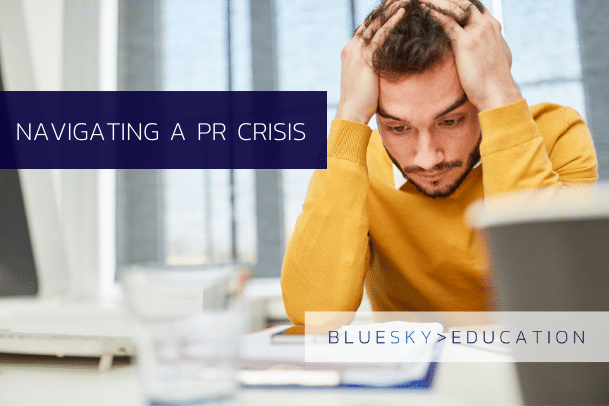
5 Ways PR Can Boost Student Applications
Across the globe, business schools and universities are locked in fierce competition for the best and brightest students. From MBA programmes to executive education courses, institutions are not only tasked with delivering world-class education - they also need to consistently attract new waves of applicants who are informed, selective, and often overwhelmed by choice.

Looking to Expand Your Communications Team? Here’s How to Ensure ROI from Day One
When considering the best way to scale your communications efforts, a common question arises: Should start-ups hire in-house PR experts, or outsource to specialised PR agencies? Unfortunately, there is no simple yes-or-no answer.

Why PR Will Keep Student Applications Rolling in Over the Holidays
As the holiday season approaches, professors, students, and staff are looking forward to a much-needed break after what has likely been a busy and challenging year. While the festive period is a time for relaxation and celebration, it is also an excellent opportunity for business schools to make a lasting impression on prospective students.

6 reasons you should consider podcast opportunities for your faculty
Business schools face the ongoing challenge of staying relevant and engaging to both current and prospective students as well as other key stakeholders. One innovative strategy that can significantly enhance a business school’s visibility and influence is by leveraging faculty members in podcast opportunities. By putting faculty forward for podcasts, business schools can amplify their thought leadership, connect with wider audiences, and enrich their educational offerings.

Should academic experts combat online misinformation?
Rewind to 2017, in the aftermath of the Brexit vote, prominent Brexiteer Michael Gove famously said “people in this country have had enough of experts”. Though to many this seemed like a stupid statement – surely you can trust the experts the most?

How to do PR in Africa
Africa is the youngest continent in the world. In fact, according to the UN, 70% of sub-Saharan Africa is under the age of 30. Take this in comparison to the European Union, where less than 35% of citizens are under 30, the sheer number of young people across the continent offers an opportunity for huge growth.

How to secure business school coverage in a changing press landscape
If there’s one thing we’ve learned over the past few years, it’s that the pace that the norm can change is rapid. Whether it’s the covid pandemic changing our lives overnight, geopolitical events like conflicts or climate disasters disrupting the usual order, or new technologies drastically altering our habits – external factors can have a profound and quick impact on pretty much anything.

6 Common misconceptions of PR
My journey with public relations started over 10 years ago. It’s now been over a decade since I signed up to study Public Relations & Communications as an undergraduate. Back then I remember family and friends asking me “So what actually is public relations?”.

How can public relations support marketing activities?
For those who don’t work in the field of communications, it is very easy to assume that public relations and marketing are pretty much the same thing. In fact, you’d find it hard to come by a PR professional who hasn’t described their job as ‘similar to marketing’ to their family, friends or virtually anyone new they meet.

Why a compelling brand message is needed for PR
Some business schools that are world-renowned – whether that’s the likes of Harvard, Stanford or Wharton – can simply rely on little else than their reputation to attract the world’s best faculty, students and corporate partners.

Why should faculty be media trained? What does it involve?
We’ve all seen disastrous media interviews before. A politician, a business person, or even a sports person comes on to the TV and you can tell they are unprepared. They’ve not planned what they want to say, they are coming across as incompetent and unprofessional and they are saying ‘no comment’ to all of the difficult questions. It doesn’t look good for the spokesperson or the organisation.

Why you should use social media to boost your PR engagement
Social media is an effective tool. Not only can you engage instantly and directly with a large amount of your customer base, but you can also shape the narrative and key messaging around your brand and have control over what is posted.

Why PR shouldn’t be judged by the volume of coverage
When reporting back to your Dean or senior leaders, would you rather show them 20 individual pieces of PR coverage you’ve gained, or five? Naturally, you’re always going to say 20. Of course, the higher the number of coverage, surely the better the value for your client? But, is that always the case?

Why we are members of the Chartered Institute of Public Relations (CIPR)
Would you hire a lawyer if they hadn’t passed their accreditation board exams? Would you consult with an accountant who wasn’t ACA, ACCA or CIMA accredited? Or would you seek the help from a doctor who was not approved by medical councils?

Why content marketing is key for boosting awareness
The graduate management education world is a competitive one, there’s no denying that. It doesn’t matter whether it’s for the top-ranking places, the best possible students or world-renowned faculty, institutions are all competing with each other to have the best of the best. And, in a small, close-knit industry, where many offer similar programmes, similar teaching and similar experiences, it’s hard to stand out of the crowd and really make noise.

How much should you be spending on a digital PR agency?
Hiring a PR agency isn’t a decision you should make lightly. Communicating your organisation’s goals and strategy in an effective and successful manner is a crucial part of business, and selecting an agency to accelerate and enhance this is an incredibly important decision.

How to demonstrate the value of your press coverage
For as long as public relations has existed, the industry has needed to demonstrate the value of press coverage. At the end of the day, it showcases the value of the work, maintains interest in comms expertise, helps to justify investments in PR, and helps to prove it’s worth.

6 tips on how to implement a long-term PR strategy effectively
Public relations is no quick win. Though first impressions certainly do count, you might not change people’s minds, their behaviour or make them act differently on your first engagement with them. It’s often a lengthy process, which takes time and patience – at the end of the day people don’t generally jump into decisions lightly.

How to use news trends to gain great coverage for your clients
Here are just a few examples of how to use news trends and how BlueSky Education has earned great coverage for our clients in these areas.

Understanding the media: tips for business schools and universities
Another month, another influx of pioneering research papers. But which ones are destined for the headlines? The first step to securing phenomenal press coverage for business schools and universities is to identify exactly which research, and which student or alumni success stories, are most likely to catch the media’s attention. It’s equally vital to know when material lends itself to a press release, to an opinion editorial or to interview articles.

How can PR set your brand apart from others?
Some brands are simply just synonymous with what they want to be known for. Apple are synonymous with leading cutting-edge technology, Tesla with cutting-edge manufacturing innovation and BlueSky Education, with unrivalled education PR knowledge 😉

What is graduate management education? And how to use PR to promote it
In 1819, ESCP business school, as it’s now known today, was launched as a Ecole Spéciale de Commerce et d'Industrie, teaching students on key topics like entrepreneurship and business. This was the birth of graduate management education, and helped forge the pathways for other leading institutes in this area like Harvard, Wharton and Stanford – who have gone on to educate, hone and develop some of the world’s leading thinkers, politicians and CEOs.

How to do PR for Executive Education
How can business schools use PR outreach to promote their Executive Education programmes? And how is it different to the promotion of other programmes?

How 2020 changed business education
In the final episode of season two of the BlueSky Education Thinking Podcast, BlueSky Education’s Stephanie Mullins, Kerry Ruffle and Katie Hurley discuss the future of business education, focusing on the rise of virtual events, along with returning guest Angus Laing, Dean of Lancaster University Management School, and an in-depth interview with fellow BlueSky Education Thinking host, Matt Symonds.

Do COVID-19 vaccines already have a PR problem? How could we tackle this?
You’d be forgiven for sometimes losing hope in the crazy year of 2020. Covid-19 has not only taken the lives of many of our loved ones, but also taken jobs, financial security and any form of ‘normal’ life as we know it. But there now appears to be a light at the end of the tunnel.

Great PR ideas from companies around the globe
2020 was a strange year. Nobody could have predicted in early January what the world would look like post-March, as staying indoors, not hugging your friends and wearing face masks became normal. The turbulence and uncertainty has been a nightmare for organised public relations and marketing experts, who’d likely planned their strategy and activities for the year ahead.

5 reasons why Covid-19 should be the focus of your content marketing
Covid-19 has proven to be a real test for higher education institutions. The industry has been completely turned upside down over night. Though new research suggests student recruitment numbers are likely to still be fairly high in the UK, the Covid-19 period has still been financially challenging. So much so, that 13 UK universities announced this week they may be going bust without a government bailout.

PR lessons from your competitors – key takeaways for media success
No matter what industry you work in, it is both natural and probably a wise idea to closely follow what your competitors are doing in the market. Whether that be new ideas or innovations, new products or services or something simply eye-catching to a key audience, it is important to keep on top of what is going on around your institution. What is even more important, however, is being the institution that all your competitors are talking about (positively, of course).

How PR can attract new students
There are a vast number of reasons as to why business schools want, and need, to engage in PR. Whether it is to highlight some of the ground-breaking academic research from their professors, announce a new programme at the school or promote their faculty’s expertise – all of which are enhanced and have more impact through the use of PR.

How can you measure the business school PR return on investment?
Worthwhile investments must offer a return. Whether it is in a specific stock you have a hunch about, funding a business you like the idea of, or purchasing a property – you are always looking for results from that investment. But, in most of these, you are easily able to quantify whether your risk paid off, through stats and figures – did the stock you invested in go up? Did the company you invest in increase its value? Did the price of your house increase? Investing in public relations, however, can be a little more difficult to quantify in terms of return on investment.

How to get coverage in HR press
Human resources is an interesting topic. However, many may feel they can’t relate to the role of a HR Director, or that HR decisions have no impact on them – but, this is not the case. Every single company in the world has to have a HR professional, or at least have to make decisions that would fall under the HR function.

Should out-of-working hours e-mails be banned? - International PR
You may have seen an interesting research study hit the headlines last week. Researchers from the University of Sussex released findings from a study into out-of-work hour e-mails, which suggested that banning staff from accessing their work emails outside office hours could actually do more harm than good to employee well-being. These findings, of course, featured heavily in the press, sparking huge debate not only in the comments section of the Daily Mail (what doesn’t?), but on social media and, I imagine, many workplaces – whether they be open-plan, virtual, remote or co-working.

How to structure a press release based on academic research
Producing innovative and influential academic research is one of the best ways a business school can make itself stand out in a crowded market. In fact, academic research is now so important to a business school’s brand that leading business education news site, Poets & Quants, recently created a new ranking selecting the top 100 business schools for academic research in the world. And it’s no surprise that globally known brands, such as Harvard, Wharton and NYU Stern, finished at the top for academic research too. It’s clear that both a strong brand and strong, impactful academic research go hand in hand in the business school world.

How to effectively work with media in the US
With a population of just over 329 million people, making it the third most populous country in the world, the USA is clearly going to be a key media target for any institution. But, more importantly, according to GMAC’s 2018 Applications Trends survey, 140,000 out of an overall 290,000 business school applications last year came from US-based applicants – over three times the size of applicants in Europe alone.

How to ensure your content has as much impact as possible
There are no two ways about it, creating great, insightful content for your institution is always a good thing. However, it is extremely difficult to measure how much of real impact each piece of content actually has on the reader and whether or not this has a long-lasting effect.

International PR offices – are they needed for international coverage?
You’re looking for a PR firm to help out with your international PR efforts and come across a firm that states “we have offices based in New York, London, Hong Kong, Paris and Berlin, in order to penetrate our key markets in the most effective way possible”.

How do you differentiate your business school from others?
In November, I had the pleasure of hearing from and spending time with representatives from some of Europe’s best and well-known business schools, at the GMAC European Conference in Berlin.

How PRs should use Twitter as a professional tool
Social media platform Twitter boasts over 330 million global users, and has quickly become the go to site for journalists, PRs and the general population, to view and share news. With around three quarters of journalists using Twitter every day and over 70% of them stating that Twitter is a valuable professional tool, it harnesses the potential to be a great platform for PRs to utilise, to the benefit of themselves and their clients.

5 tips to make your pitch stand out from the crowd
Journalist’s jobs are becoming more and more time-pressed, with their inboxes increasingly flooded with PR’s pitches. Now more than ever, for a journalist to buy into a pitch, it needs to capture their attention. But how as a PR can you make your pitch stand out from the crowd ? Make sure it's newsworthy Journalists are inundated with pitches daily, so ones that are boring, uninteresting, and un-newsworthy are destined to fail before they’ve even been sent. ‘The 5 best paints to watch dry’, for example, will never get coverage no matter how amazing your pitch is, or how slow a news week it has been. It is a PR’s responsibility to evaluate whether or not their story is newsworthy before pitching it. Deciding this beforehand stops you from wasting both yours and the journalist’s time, and avoids disappointment when your efforts inevitably fail to deliver results. Have a creative, engaging headline The first part of a pitch that a journalist will read is the headline, and many journalists will decide whether or not they will bother to read on purely based on how interesting that headline is. This is why it is important you pay as much attention to crafting an effective email header as you do to your pitch, as this will encourage the journalist to read more. Make it relevant You could write the most amazing pitch in the world, but if it isn’t pitched to the right publication, it will never be read. For instance, a pitch about a world-changing bacon product that actually makes you lose weight (if only!!), will never be read if you’re pitching it to ‘The Vegetarian News’. Of course this is an extreme example, however it has its relevance. It is important that, as a PR, you research exactly which publications are interested in the news you wish to share and, more importantly, which journalists from these publications are writing about it. This does take time, but it is a worthwhile exercise. After all, it is far better to pitch to five relevant journalists than scatter your pitch to 50 journalists who are not. Make it short and snappy Journalists barely have time in their day to open all their e-mails, let alone read them thoroughly. So, what makes you think they will have time to read your pitch, which is as long as a thesis? You must make your pitch short, snappy and to the point, summarising the story and ensuring the journalist can fully understand its significance. Cut out all of the unnecessary information – a journalist will not want to read waffle. It is important to ensure that every single word in your pitch is carefully selected leaving the journalist wanting to know more. A pitch should be like a wine tasting, the journalist should have a small glass, and want to come back to you for the whole bottle. Do not oversell

Four tips on how to deal with a PR crisis
There is no such thing as a smoothly run business. All companies and institutions will have their ups and downs, their challenges and successes, and unfortunately even the best businesses at some point in their lifecycle will face a PR crisis eventually.
